| CHAPTER I: INTRODUCTORY—THE USE OF BOOKS IN EARLY IRISH
MONASTERIES Old English libraries; the making, collection and use of books during the middle ages | ||
1. CHAPTER I: INTRODUCTORY—THE USE OF BOOKS IN EARLY IRISH MONASTERIES
1. § I
—Inscribed in MS. of Life of Barlaam and Josaphat, Peterhouse, Camb.
TO people of modern times early monachism must seem an unbeautiful and even offensive life. True piety was exceptional, fanaticism the rule. Ideals which were surely false impelled men to lead a life of idleness and savage austerity,—to sink very near the level of beasts, as did the Nitrian hermits when they murdered Hypatia in Alexandria. But this view does not give the whole truth. To shut out a wicked and sensual world, with its manifold temptations, seemed the only possible way to live purely. To get far beyond the influence of a barbaric society, utterly antagonistic to peaceful religious observance, was clearly the surest means of achieving personal holiness. Monachism was a system designed for these ends. Throughout the Middle Ages it was the refuge—the only refuge—for the man who desired to flee from sin. Such, at any rate, was the truly religious man's view. And if monkish retreats sheltered some ignorant fanatics, they also attracted many
By great good fortune, then, the studious occupations which did so much to soften monkish austerities in the Middle Ages, were recognised early as needful to the system. Even the ascetics by the Red Sea and in Nitria did not deprive themselves of all literary solace, although the more fanatical would abjure it, and many would be too poor to have it. The Rule of Pachomius, founder of the settlements of Tabenna, required the brethren's books to be kept in a cupboard and regulated lending them. These libraries are referred to in Benedict's own Rule. We hear of St. Pachomius destroying a copy of Origen, because the teaching in it was obnoxious; of Abba Bischoi writing an ascetic work, a copy of which is extant; of anchorites under St. Macarius of Alexandria transcribing books; and of St. Jerome collecting a library summo studio et labore, copying manuscripts and studying Hebrew at his hermitage even after a formal renunciation of the classics, and then again, at the end of his life, bringing together another library at Bethlehem monastery, and instructing boys in grammar and in classic authors. Basil the Great, when founding eremitical settlements on the river Iris in Pontus, spent some time in making selections from Origen. St. Melania the younger wrote books which were noted for their beauty and accuracy. And when Athanasius introduced Eastern monachism into Italy, and St. Martin of Tours and John Cassian carried it farther afield into Gaul, the same work went on. In the cells and caves of Martin's community at Marmoutier the younger monks occupied their time in writing and sacred study, and the older monks in prayer. [1.1] Sulpicius Severus
2. § II
Monachism of this Eastern type came from Gaul to Ireland. [1.4] St. Patrick received his sacred education at Marmoutier; under Germanus at Auxerre; and possibly at Lerins. His companions on his mission to Ireland, and the missionaries who followed him, nearly all came from the same centres. Naturally, therefore, the same practices would be observed, not only in regard to religious discipline and organisation, but in regard to instruction and study. Even the mysterious Palladius, Patrick's forerunner, is said
This was the dawn of letters for Ireland. By disseminating the Scriptures and these primers, Patrick and his followers, and the train of missionaries who came afterwards,[1.9] secured the knowledge and use of the Roman alphabet. The way was clear for the free introduction of schools and books and learning. "St. Patrick did not do for the Scots what Wulfilas did for the Goths, and the Slavonic apostles for the Slavs; he did not translate the
Mainly owing to the labours of Dr. John Healy, we now know a good deal about the somewhat slow growth of the Irish schools to fame; but for our purpose it will do to learn something of them in their heyday, when at last we hear certainly of that free use of books which must have been common for some time. From the sixth to the eighth century Ireland enjoyed an eminent place in the world of learning; and the lives and works of her scholars imply book-culture of good character. St. Columba was famed for his studious occupations. Educated first by Finnian of Moville, then by another tutor of the same name at the famous school of Clonard, he journeyed to other centres for further instruction after his ordination. From youth he loved books and studies. He is represented as reading out of doors at the moment when the murderer of a young girl is struck dead. In later life he realized the importance of monastic records. He had annals compiled, and bards preserved and arranged them in the monastic chests. At Iona the brethren of his settlement passed their time in reading and transcribing, as well as in manual labour. Very careful were they to copy correctly. Baithen, a monk on Iona, got one of his fellows to look over a Psalter which he had just finished writing, but only a single error was discovered. [1.11] Columba himself became proficient in copying and illuminating. He could
A quarrel about a book, we are told, changed his career. He borrowed a Psalter from Finnian of Moville, and made a copy of it, working secretly at night. Finnian heard of the piracy, and, as owner of the original, claimed the copy. Columba refused to let him have it. Then Diarmid, King of Meath, was asked to arbitrate. Arguing that as every calf belonged to its cow, so every copy of a book belonged to the owner of the original, he decided in Finnian's favour. Columba thought the award unjust, and said so. A little later, after another dispute with Diarmid on a question of monastic immunity, he called together his tribesmen and partisans, and offered battle. Diarmid was defeated. For some reason, not quite clear, these quarrels led to Columba's voluntary exile(c. 563). He sailed from Ireland,
Not only to the far north, but to the Continent, did the Irish press their energetic way. In Gaul their chief missionary was Columban (c. 543 -615), who had been educated at Bangor, then famous for the learning of its brethren. His works display an extensive acquaintance with Christian and Latin literature. Both the Greek and Hebrew languages may have been known to him, though this seems improbable and inconceivable.[1.15] In his Rule he provides for teaching in schools, copying manuscripts, and for daily reading.[1.16]
The monasteries of Luxeuil, Bobio, and St. Gall, founded by him and his companions on their mission in Gaul and Italy, became the homes of the most famous conventual libraries in the world—a result surely traceable to the example set by the Irish ascetics, and to the tradition they established.[1.17]
Other Irish monks are better known for their literary attainments than for missionary enterprise. St. Cummian, in a letter written about 634, displays much knowledge of theological literature, and a good deal of knowledge of a general kind.[1.18] Another monk named Augustine (c. 650) quotes from Eusebius and Jerome in a work affording many other evidences of learning. [1.19] Aileran (c. 660), abbot of Clonard, wrote a religious work which proves his acquaintance with Jerome, Philo, Cassian, Origen, and Augustine. [1.20]
An Englishman supplies valuable evidence of the state of Irish learning. Aldhelm's (c. 656-709) works prove him to have had access in England to a good library; while in one learned letter he compares English schools favourably with the Irish, and declares Theodore and Hadrian would put Irish scholars in the shade. Yet he is on his mettle when communicating with Irish friends or pupils; he clearly reserves for them the flowers of his eloquence. [1.21] The Irish schools were indeed successful rivals of the English schools, and Irish scholars could use libraries as good, or nearly as good, as that at Aldhelm's disposal. At this time the attraction which Ireland and Iona had for English students was extraordinary.
In 664 many English, both high and low in rank, left their native land for Ireland, where they sought instruction in sacred studies, or an opportunity to lead a more ascetic life. Some devoted themselves faithfully to a monkish career. Others applied themselves to study only, and for that purpose journeyed from one master's cell to another. The Irish welcomed all comers. All received without charge daily food: barley or oaten bread and water, or sometimes milk cibus sit vilis et vespertinus—a plain meal, once a day, in the afternoon. Books were supplied, or what is more likely, waxed tablets folded in book form. Teaching was as free as the open air in which it was carried on.[1.24]
Among the English at one time or another taking advantage of Irish hospitality were Gildas (c. 540), first native historian of England;[1.25] Ecgberht, presbyter, a Northumbrian of noble birth; Ethelhun, brother of Ethelwin, bishop of Lindsay; Oswald, king of Northumbria; Aldfrith, another Northumbrian king, who was educated either in Ireland or Iona; Alcuin, who received instruction at Clonmacnoise;[1.26] one named Wictberht, "notable . . . for his learning and knowledge, for he had lived many years as a stranger and pilgrim in Ireland"; and St. Willibrord, who at the age of twenty journeyed to Ireland for purposes of study, because he had heard that learning flourished in that country.[1.27]
3. § III
Most of the references we have made above belong to the sixth and seventh centuries, usually regarded as the best age of Irish monachism. But the Irish enjoyed their reputation unimpaired for a long time. Just before and after the Northmen descended on their land in 795, we find them making their mark abroad, not so much as missionaries but as scholars and teachers.[1.28]
A few instances will suffice. "The Acts of Charles, written by a monk of St. Gallen late in the ninth century, tells us of `two Scots from Ireland,' who `lighted with the British merchants on the coast of Gaul,' and cried to the crowd, `If any man desireth wisdom, let him come unto us and receive it, for we have it for sale.' They were soon invited to the court of Charles. One of them, Clement, partly filled the place of Alcuin as head of the palace school." [1.29] His reputation soon became widespread, and the abbot of Fulda sent several of his most capable monks to him to learn grammar.[1.30] His companion, Dungal, went on to Italy. He enjoyed a full share of the learning of his time; was a student of Cicero and Macrobius; knew Virgil well; and had some Greek.[1.31] A few fine books were bequeathed by him to the Irish monastery of Bobio, where copies were written and distributed through Italy. According to the learned Muratori, in one of these manuscripts is an inscription proving Dungal's ownership.[1.32] One
Clement and Dungal were not the only Irishmen of note on the Continent. One, Dicuil, was an exponent of geography. He founded his treatise (c. 825) on Cæsar, Pliny, and Solinus; he quotes and names many other writers, including fourteen Greek; and generally impresses us with his earnest studentship. An Irish monk named Donatus wandered to Italy and became bishop of Fiesole (c. 829); he, too, was a scholar acquainted with Virgil, a teacher of grammar and prosody, and a lecturer on the saints.[1.33] Sedulius, the commentator, an Irish monk of Liége, copied Greek psalters, wrote Latin verses, knew Cicero's letters, the works of Valerius Maximus, Vegetius, Origen, and Jerome; was well acquainted with mythology and history, and perhaps had some Hebrew. [1.34] Another Irishman, John the Scot (Joannes Scotus Erigena), became the most eminent scholar of his time: he alone, among all the learned men Charles the Bald had about him, was able to translate from Greek (c. 858-860). Well might Eric of Auxerre, writing to Charles, express his astonishment at this train of philosophers from Ireland, that barbarous land on the confines of the world.[1.35] All these wanderers, and many more, must have been responsible for the dissemination of the books produced by Irish hands; and, in fact, many manuscripts of Celtic origin and early in date, are still on the Continent, or have been found there and brought to Ireland.[1.36]
In some respects the evidence of book-culture in Ireland in these early centuries is inconsistent. The jealous guard Longarad kept over his books, the quarrel over Columba's Psalter, and the great esteem in which scribes were held,[1.37] suggest a scarcity of books. The practice of enshrining them in cumdachs, or book-covers, points to a like conclusion. On the other hand, Bede tells us the Irish could lend foreign students books, so plentiful were they. His statement is corroborated by the number of scribes whose deaths have been recorded by the annalists, the Four Masters, for example, note sixty-one eminent scribes before the year 900, forty of whom belong to the eighth century.[1.38] In some of the monasteries a special room for books was provided. The Annals of Tigernach refer to the house of manuscripts. [1.39] An apartment of this kind is particularly mentioned as being saved from the flames when Armagh monastery was burned (1020). Another fact suggesting an abundance of books was the appointment of a librarian, which sometimes took place. [1.40] Although a special book-room and officer are only to be met with much later than the best age of Irish monachism, yet we may reasonably assume them to be the natural culmination of an old and established practice of making and using books.
Such statements, however, are not necessarily contradictory.
Manuscripts over which the cleverest scribes and illuminators had spent
much time and pains would be jealously preserved in cases or shrines;
still, when we remember how many precious fruits of the past must have
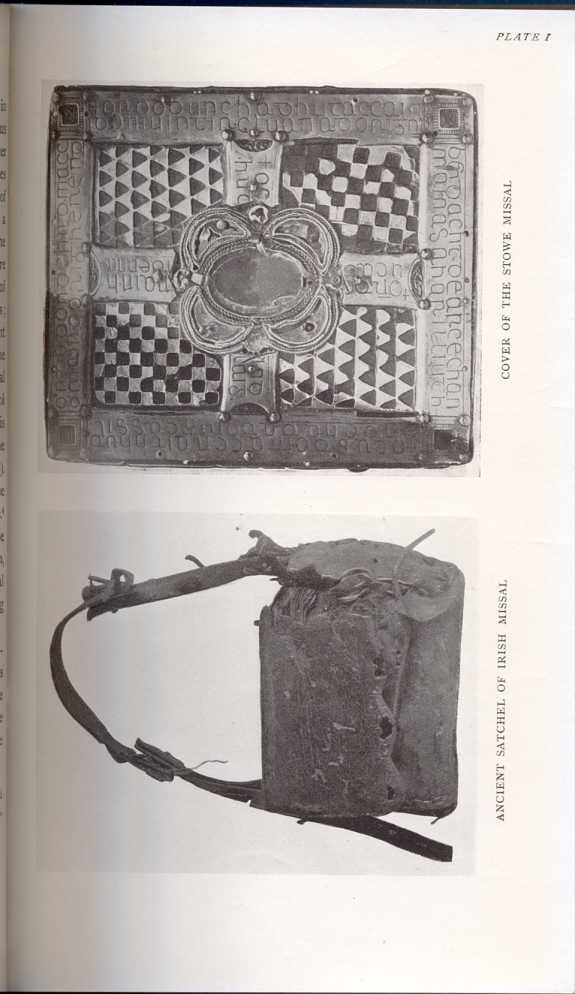 [Description: ANCIENT SATCHEL OF IRISH MISSAL
COVER OF THE STOWE MISSAL]
[Description: ANCIENT SATCHEL OF IRISH MISSAL
COVER OF THE STOWE MISSAL]
4. § IV
Our account of the work accomplished by the Irish monks would be incomplete without reference to their writing, illuminating, and book-economy, the relics of which are so finely rare.
The old Irish runes gave place slowly to the Roman alphabet, which came into use, as we have already observed, after St. Patrick's mission. This new writing was in two forms—round and pointed—but both were derived from the Roman half-uncial style. The clear and beautifully-shaped
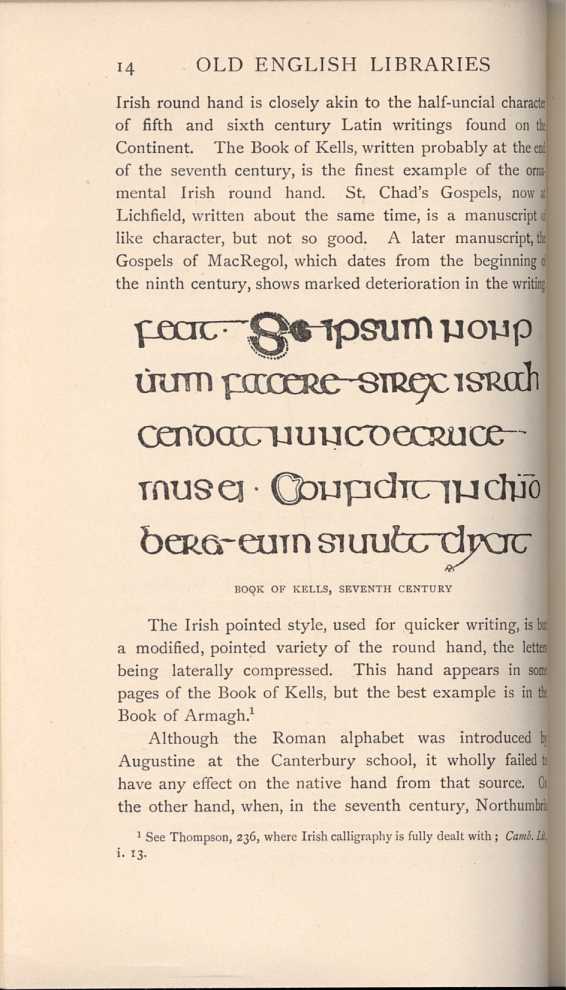 [Description: BOOK OF KELLS, SEVENTH
CENTURY]
[Description: BOOK OF KELLS, SEVENTH
CENTURY]The Irish pointed style, used for quicker writing, is but a modified, pointed variety of the round hand, the letters being laterally compressed. This hand appears in some pages of the Book of Kells, but the best example is in the Book of Armagh.[1.43]
Although the Roman alphabet was introduced by Augustine at the
Canterbury school, it wholly failed to have any effect on the native
hand from that source. On the other hand, when, in the seventh century,
Northumbria
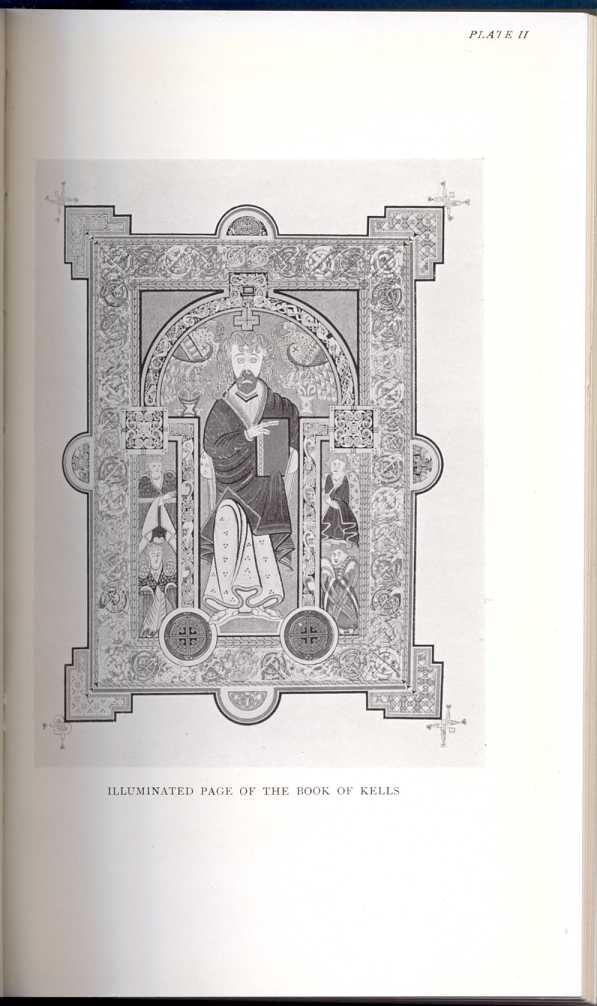 [Description: ILLUMINATED PAGE OF THE BOOK OF
KELLS]
[Description: ILLUMINATED PAGE OF THE BOOK OF
KELLS]
Irish illumination is as characteristic as the writing. Pictures
and drawings of the human figure are not so common as in the work of
other schools, and when they do appear are not often good. Still, some
of them, as the scenes from the life of Christ in the Book of Kells, are
quite unlike the illuminations of any other school; while the
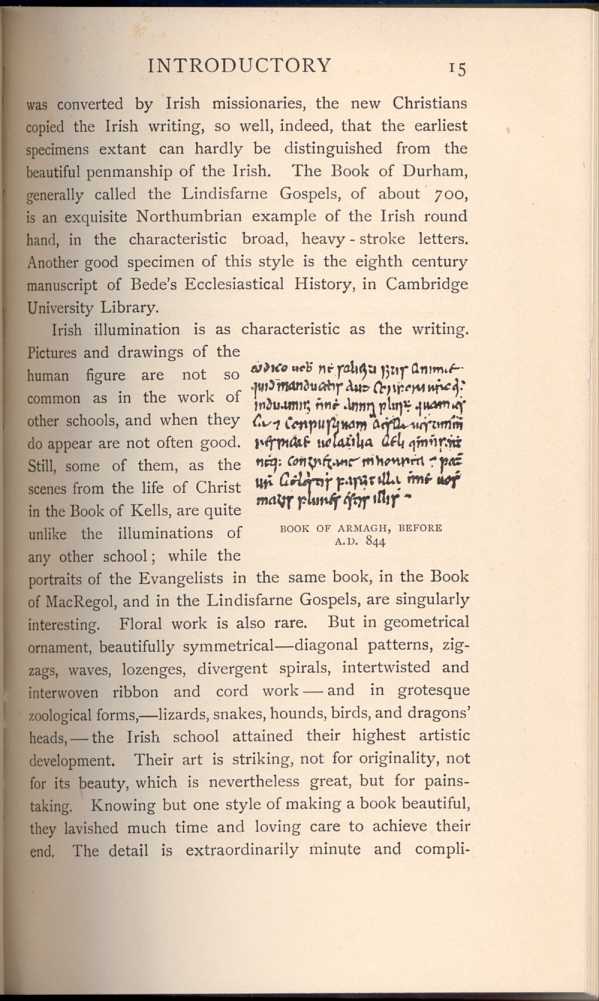 [Description: BOOK OF ARMAGH, BEFORE
A. D. 844]
[Description: BOOK OF ARMAGH, BEFORE
A. D. 844]
Of intricate geometrical ornament and grotesque figures, the illumination representing the symbols of the Four Evangelists (fo. 290) of the Book of Kells is perhaps the best example. Of divergent spirals and interlaced ribbon work the frontispiece of St. Jerome's Epistle in the Book of Durrow affords notable examples. Two of the peculiar features of Irish decoration—the rows of red dots round a design and the dragon's head—appear in the earliest, or nearly the earliest, Irish manuscript extant, namely, the Cathach Psalter, now in the Museum of the Royal Irish Academy. Whether the essential and peculiar features of this ornamentation are purely indigenous, as Professor Westwood contends, or whether they are of Gallo-Roman origin, as Fleury argues, is a moot point, calling for complicated discussion which would be out of place here.
The amount of illumination in the existing manuscripts varies,
but the pages chosen for illuminating are nearly always the same. In the
Book of Kells the illuminations consist of three portraits of the
Evangelists, three scenes from the life of Christ, three combined
symbols of the four Evangelists, eight pages of the Eusebian canons, and
many
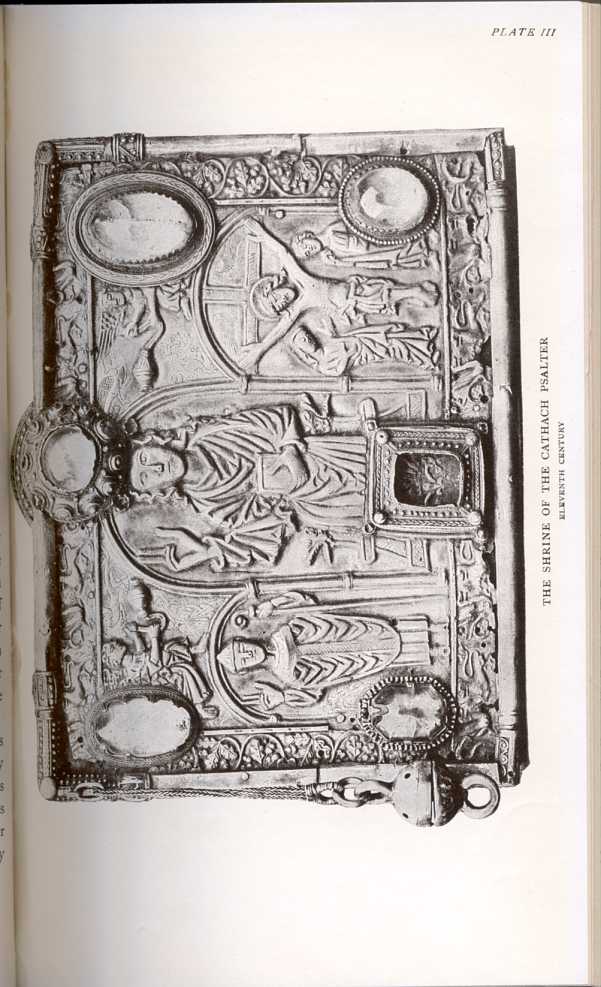 [Description: THE SHRINE OF THE CATHACH PSALTER
ELEVENTH CENTURY]
[Description: THE SHRINE OF THE CATHACH PSALTER
ELEVENTH CENTURY]
The oldest Irish manuscript in existence is probably the Domnach Airgrid, or manuscript of the Silver Shrine, also called St. Patrick's Gospels. Dr. Petrie believed the Domnach to be the identical reliquary given by St. Patrick to St. Mac Cairthinn, when the latter was put in charge of the see of Clogher, in the fifth century. "As a manuscript copy of the Gospels apparently of that early age is found with it, there is every reason to believe it to be that identical one for which the box was originally made."[1.44] But both case and manuscript are now held to be somewhat later in date. Another very early manuscript is the sixth century fragment of fifty-eight leaves of a Latin Psalter, styled the Cathach or "Battler." For centuries this fragment has been preserved in a beautiful case as a relic of Columba; as, indeed, the actual cause of the dispute between Columba and Finnian of Moville.
5. § V
Two features of book-economy, although not peculiar to Ireland, are rarely met with outside that country. The religious used satchels or wallets to carry their books about with them. We are told Patrick once met a party of clerics and gillies with books in their girdles; and he gave them the hide he had sat and slept on for twenty years to
The second special feature of Irish book-economy was the preservation of manuscripts in cumdachs or rectangular boxes, made just large enough for the books they were intended to enshrine. As in the case of the wallet, the cumdach was not peculiar to Ireland, although the finest examples which have come down to us were made in that country.[1.48] They are referred to several times in
By good hap, several cumdachs of the greatest interest are still
preserved for our inspection. One of them, the Silver Shrine of the
so-called St. Patrick's Gospels, is a very peculiar case. It consists of
three covers. The first or inner, is of yew, and was perhaps made in the
sixth or seventh century. The second, of copper, silver-plated, is of
later make. The third, or outermost, is of silver, and was probably made
in the fourteenth century. The cumdach of the Stowe Missal (1023) is a
much more beautiful example. It is of oak, covered with plates of
silver. The lower or more ancient side bears a cross within a
rectangular frame. In the centre of the cross is a crystal set in an
oval mount. The decoration of the four panels consists of metal plates,
the ornament being a chequer-work of squares and triangles. The lid has
a similar cross and frame, but the cross is set with pearls and
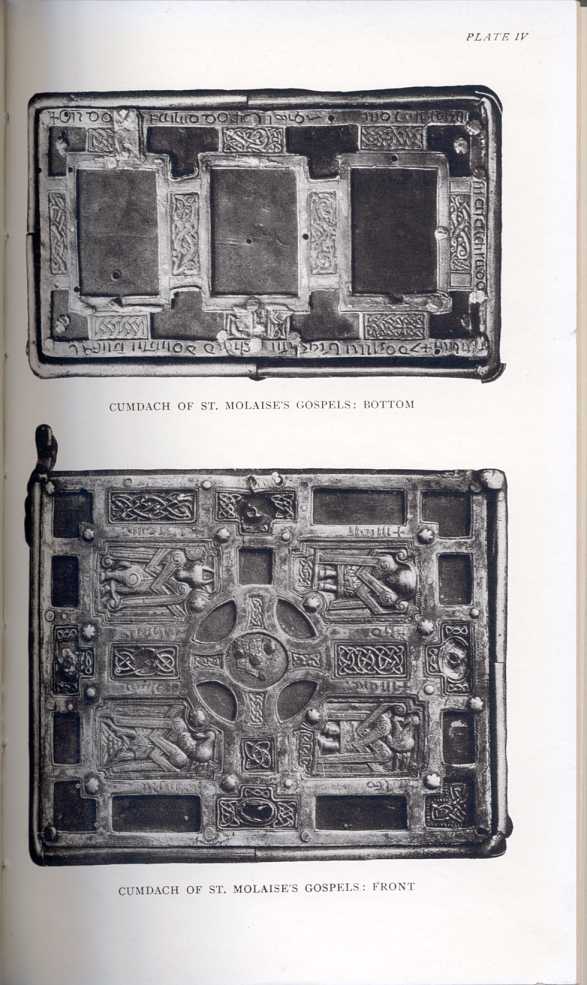 [Description: CUMDACH OF ST. MOLAISE'S GOSPELS: BOTTOM;
CUMDACH OF ST. MOLAISE'S GOSPELS: TOP]
[Description: CUMDACH OF ST. MOLAISE'S GOSPELS: BOTTOM;
CUMDACH OF ST. MOLAISE'S GOSPELS: TOP]
These are the earliest relics we have of what was undoubtedly an old and established method of enshrining books, going back as far as Patrick's time, if it be correct that Bishop Assicus made them, or if the first case of the Silver Shrine is as old as it is believed to be. The beautiful lower cover of the Gospels of Lindau, now in Mr. Pierpont Morgan's treasure-house, proves that at least as early as the seventh century the Irish lavished as much art on the outside of their manuscripts as upon the inside.[1.52] It is natural to make a beautiful covering for a book which is both beautiful and sacred. All the volumes upon which the Irish artist exercised his talent were invested with sacred attributes. Chroniclers would have us believe they were sometimes miraculously produced. In the life of Cronan[1.53] is a story telling how an expert scribe named
It was believed such books could not be injured. St. Ciaran's copy of the Gospels fell into a lake, but was uninjured. St. Cronan's copy fell into Loch Cre, and remained under water forty days without injury. Even fire could not harm St. Cainnech's case of books. [1.55] Nor is it surprising they should be looked upon as sacred. The scribes and illuminators who took such loving care to make their work perfect, and the craftsmen who wrought beautiful shrines for the books so made, were animated with the feeling and spirit which impels men to erect beautiful churches to testify to the glory of their Creator. As Dimma says, they "wrote them for God."
Abgitorium, abgatorium; elementa, elimenta. Stokes (W.), T. L., i. cliii.; also i. 111, 113, 139, 191, 308, 320, 322, 326, 327, 328.
In 536, fifty monks from the Continent landed at Cork.—Montalembert, ii. 248n. Migrations from Gaul were frequent about this time.
Dr Skene says the Psalter incident "bears the stamp of spurious tradition"; so does the Longarad story; but it is curious how often sacred books play a part in these tales.
Healy, 379; Stokes (M.) 2, 118. Ergo quotidie jejunandum est, sicut quotidie orandum est, quotidie laborandum, quotidie est legendum.
A ninth century catalogue of St. Gall mentions thirty-one volumes and pamphlets in the Irish tongue—Prof. Pflugk-Harttung, in R. H. S. (N. S.), v. 92. Becker names only thirty, p. 43. At Reichenau, a monastery near St. Gall, also famous for its library, there were "Irish education, manuscripts, and occasionally also Irish monks." "One of the most ancient monuments of the German tongue, the vocabulary of St. Gall, dating from about 780, is written in the Irish character."
Tradidit hunc librum, quo fratrum corda beentur.
Qui leges ergo Deus pretium sit muneris, org."—Healy, 392.
The following, among others, are still on the Continent: Gospels of Willibrord (Bibl. Nat. Lat. 9389, 739), Gospel of St. John (Cod. 60 St. Gall c. 750-800); Book of Fragments (No. 1395, St. Gall, c. 750-800); The Golden Gospels (Royal library, Stockholm, 871); Gospels of St. Arnoul, Metz (Nuremberg Museum, 7th c.).—Cp. Maclean, 207-8; Hyde, 267.
Hyde, 220; Stokes (M.), 10, "Connachtach, an Abbot of Iona who died in 802, is called in the Irish annals `a scribe most choice.' "—Trenholme, Iona, 32.
At vero hoc audiens Colcius tempus et horan in tabula describers.— Adamnan, 66. Columba is said to have blessed one hundred pólaires or tablets (Leabhar Breac, fo. 16-60; Stokes (M.), 51). The boy Benen, who followed Patrick, bore tablets on his back (folaire, corrupt for pólaire).—Stokes (W.), T. L., 47. Patrick gave to Fiacc a case containing a tablet. Ib. 344. An example of a waxed tablet, with a case for it, is in the Museum of the Royal Irish Academy. The case is a wooden cover, divided into hollowed-out compartments for holding the styles. This specimen dates from the thirteenth or fourteenth century. Slates and pencils were also in use for temporary purposes.—Joyce, i. 483.
Stokes (W.), T. L., 75. The terms used for satchels are sacculi (Lat.), and tiag, or tiag liubhair or teig liubair (Ir.). There has been some confusion between pólaire and tiag, the former being regarded as a leather case for a single book, the latter a satchel for several books. This distinction is made in connection with the ancient Irish life of Columba, which is therefore made to read that the saint used to make cases and satchels for books (pólaire ocus tiaga), v. Adamnan, I l 5. Cf. Petrie, Round Towers, 336-7. But the late Dr. Whitley Stokes makes pólaire or pölire, or the corruption folaire, derive from pugillares = writing tablets.—Stokes (W.), T. L., cliii. and 655. This interpretation of the word gives us the much more likely reading that Columba made tablets, and satchels for books.
Mr. Allen, in his admirable volume on Celtic Art, p. 208, in this series, says cumdachs were peculiar to Ireland. But they were made and used elsewhere, and were variously known as capsae, librorum coopertoria (e.g.... librorumque coopertoria; quædam horum nuda, quædam vero alia auro atque argento gemmis-que pretiosis circumtecta. Acta SS., Aug. iii. 659c), and thecae. Some of these cases were no doubt as beautifully decorated as the Irish cumdachs. William of Malmesbury asserts that twenty pounds and sixty masks of gold were used to make the coopertoria librorum Evangelii for King Ina's chapel. At the Abbey of St. Riquier was an "Evangelium auro Scriptum unum, cum capsa argentea gemmis et lapidibus fabricata. Aliae capsae evangeliorum duae ex auro et argento paratae."—Maitland, 212. In 1295 St. Paul's Cathedral possessed a copy of the Gospels in a case (capsa) adorned with gilding and relics.—Putnam, i. 105-6.
| CHAPTER I: INTRODUCTORY—THE USE OF BOOKS IN EARLY IRISH
MONASTERIES Old English libraries; the making, collection and use of books during the middle ages | ||